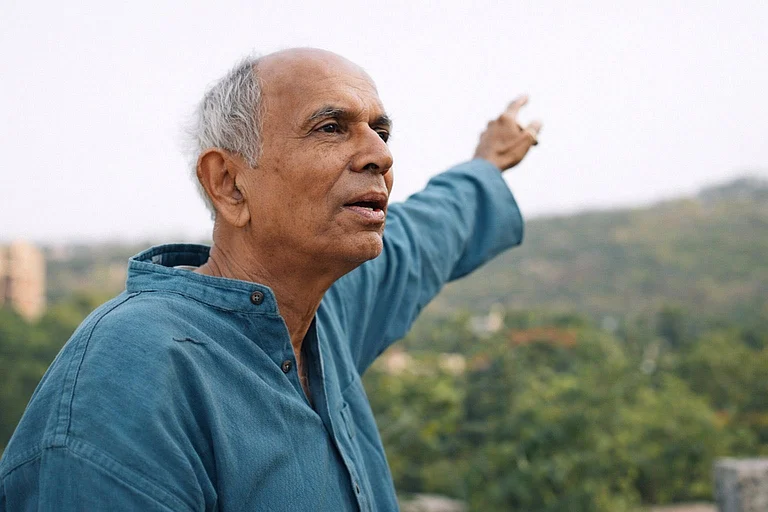For over three centuries, the rear wall or the western wall of the Gyanvapi mosque in the north Indian town of Varanasi, Uttar Pradesh, has stood as the supposed testimony of a mosque built on the ruins of a Hindu temple. Even though the mosque itself was renovated several times, the remains of the pre-existing architecture were left untouched. It stood as an anomaly in the Islamic structure carrying various Hindu motifs.
Now, the government institution, the Archaeological Survey of India (ASI), has confirmed the western wall to be part of a pre-existing “large Hindu temple”.
“It can be said that there existed a Hindu temple prior to the construction of the existing structure,” says the report, which was shared last week with both the Hindu side and the Muslim side in an ongoing legal battle over the land on which the mosque stands.
“The western wall of the mosque, which is made of stones and decorated with mouldings, is the remaining part of an earlier Hindu temple,” the 849-page report says, adding that part of the pre-existing temple was modified and reused in the mosque.
According to the report, the erstwhile temple had four chambers and the eastern half of the western chamber still exists whereas the superstructure of the western half has been destroyed. It is the eastern half of the pre-existing temple’s western chamber that forms the mosque’s western wall.
The report says that an Arabic-Persian inscription found inside a room mentions that the mosque was built in the 20th regnal year of Mughal emperor Aurangzeb, which corresponds to 1676-77.
On the other hand, a pillar decorated with bells and niches for keeping lamps on all four sides, and bearing an inscription of Saitivat 1669 (corresponding to 1613), was found in a cellar of the mosque. It belonged to the pre-existing structure.
Since the survey was conducted under the instruction of a court hearing a litigation on the ownership of the land plot, the ASI’s report is likely to have great socio-political and legal implications in the coming years, having the potential to pave way for a temple reconstruction movement around the 17th-century mosque.
Coming soon after the Prime Minister Narendra Modi-led consecration of the Ram Temple on the once-contested Ayodhya land where the Babri masjid stood until demolished in December 1992, the ASI report has all the potential to revive the old slogan of India’s Hindu nationalists: “Ayodhya ek Jhanki Hai/ Mathura-Kashi baki hai (Ayodhya is only one jolt, Mathura and Kashi are still on the cards)”.
The Muslim side in the ongoing litigation said they disagree with many of the ASI’s “conjectures and interpretations”, which they will question in court.
The existing Vishwanath temple sitting adjacent to the mosque was reconstructed in 1777 by the queen Ahalyabai Holkar. The two structures peacefully coexisted for decades, barring occasional tension, and Hindus used to regularly worship goddess Sringar Gauri at the western side of the mosque. This practice was stopped in 1993, months after the demolition of the Babri masjid raised security concerns among the mosque authorities as well as the district administration.
‘Not Surprising’
The use of ruins of pre-existing architecture has been observed in several medieval period Muslim architecture in India. Archeologists had earlier said that it does not necessarily mean the latter structure was built after destroying an existing one. Sometimes, materials from ruins were used for convenient availability of construction materials, many historians and archeologists had previously said.
However, in the case of Gyanvapi, the ASI report has not surprised historians and archeologists. A historian, who does not want to speak on record without having first gone through the ASI report, tells Outlook that Gyanvapi mosque not only carries the architectural remains of an older structure but also the destruction of the Vishweshwara (Shiva) temple during the Mughal emperor Aurangzeb’s reign is well documented.
In his 1831 book, titled ‘Benares Illustrated: In A Series of Drawings', British scholar James Princep described the mosque as the “Jumma Musjid or principal mosque of the city” and that the dome and minaret surmounting the walls of the Hindu structure “are the work of Aurangzeb.”
“Antiquarians will be well pleased that the Moosulmans, in their zeal for the triumph of their own religion, discovered a method of converting the original structure into a capacious Masjid, without destroying above one-half of its walls; so that not only the ground plan, but the entire architectural elevation, may still be traced out,” Princep wrote.
“The Gyan-kup, or well of knowledge, stands in the large quadrangle between the Golden Temple and the mosque of Aurangzeb, which is built on the site of the old Vishweshwar temple,” wrote EB Havel, the former head of the government school of art in Kolkata, in his 1905 book, Benares the Sacred City.
Historian Jadunath Sarkar’s 1947 translation of Saqi Mustad Khan’s book, ‘Maasir-I-Alamgiri: A History of the Emperor Aurangzeb - Ãlamgir (reign 1658-1707 A.D.)’, was more precise. It said, “It was reported that, according to the Emperor's command, his officers had demolished the temple of Viswanath at Kashi” in September 1669.
In her 1983 book, ‘Banaras, City of Light,’ historian Diana L Eck gave quite a detailed account of the temple, destroyed and reconstructed over several previous centuries. According to her, the last reconstruction, “perhaps on the most magnificent scale ever”, was undertaken by the Sanskrit scholar Narayana Bhatta in 1585, when “the mood of the age improved with the reign of Akbar.”
She said that it was with the patronage of one of Akbar’s courtiers, Todar Mal, whose son ruled the Jaunpur area for the Emperor, that the reconstruction proceeded.
“The temple was grand in scale and execution, consisting of a central sanctum, the garbha griha, surrounded by eight pavilions, or mandapas… In less than a century, in 1669, it was torn down at the command of the Mughal Emperor Aurangzeb. Half-dismantled, it became the foundation for the present Jnana Vapi Mosque,” she wrote.
In May 2022, historian Irfan Habib, known as among the foremost authorities on the Mughal period, said that there was no doubt that Aurangzeb got this temple destroyed and records with dates were available. Similarly, he said, the Keshav Rai temple built by Bir Singh Bundela in Mathura had also been destroyed by Muslim rulers.
“The question is, can you now destroy a masjid that had been built in 1670?” Habib had asked. While pointing out that stones of Buddha Bihars have been found in many temples in the country, he added, “Does this imply those temples should be destroyed?”
Notably, there is also a high court order for a survey at the Shahi Idgah mosque in Mathura, with Hindu petitioners reclaiming the land belonging to the erstwhile temple. The Supreme Court in January stayed the high court order. The Idgah mosque was built in 1670.
ASI’s Findings
According to the ASI’s report, existing architectural remains, decorated mouldings on the walls, karna-ratha and prati-ratha of the central chamber, large decorated entrance gate with torana on the eastern wall of the western chamber, a small entrance with a mutilated image on lalatbimba, and birds and animals carved for decoration in and outside suggest that the western wall is remaining part of Hindu temple.
The survey concludes that the central chamber of the pre-existing structure (temple) forms the central hall of the existing structure (mosque).
“This structure with thick and strong walls, along with all architectural components and floral decorations, was utilised as the main hall of the mosque. Animal figures carved at the lower ends of decorated arches of the pre-existing structure were mutilated, and the inner part of the dome is decorated with geometric designs,” the report says.
It says that for the enlargement of the mosque and construction of a sahan (courtyard) and pillared verandah, “parts of the pre-existing temple such as pillars, pilasters, etc. were reused with little modifications as per the requirement of the changed use.”
The survey recorded a total of 34 inscriptions in Devanagari, Grantha, Telugu and Kannada scripts on the existing and pre-existing structures. “These are, in fact, inscriptions on the stones of the pre-existing Hindu temples, which have been re-used during the construction/repair of the existing structure,” the report says, adding, “Reuse of earlier inscriptions in the structure suggests that the earlier structures were destroyed.”
Three names of deities such as Janardhana, Rudra, and Umesvara are found in these inscriptions. “Term such as Maha-muktimandapa mentioned in three inscriptions is of great significance,” says the report.
ASI carried out the scientific investigations and survey using technologies such as Ground Penetrating Radar (GPR), Differential Global Positioning Systems (DGPS), Total Station Survey, Handheld X-ray fluorescence (XRF), Thermo-hygrometer, Radiocarbon Dating (C4), Thermoluminescence (TL)/ Optically Stimulated Luminescence (OSL) Dating, Isotopic Dating and typological dating.
The report says that the study of the pillars revealed that pillars with square sections having lotus medallions in the centre and flower bud chains on the corner were part of the pre-existing Hindu temple. These pillars and pilasters are reused in existing structures after removing vyala figures and converting that space into floral designs.
It documented a total of 402 objects, of which 259 were stone objects, 113 were metal objects, and 27 were terracotta objects. Of the stone objects, 176 are architectural members, 55 are full or broken parts of sculptures, and five are inscription slabs.
It identified several cylindrical stones as broken parts of Shiva Linga. The 55 stone sculpture parts included 15 parts of what have been identified as Shiva Linga and Yoni Pattam, 5 full or broken Hanuman, 3 each of Vishnu and Ganesha, and two fragmentary images of Krishna and two damaged sculptures of Nandi, Shiva’s bull.
Most of the supposed Shiva Linga and Yoni Pattam were found in one of the southern cellars of the mosque and the western wall area. A miniature shrine with sculptural depiction of deities is described as “another noteworthy find.”
The ASI report says that the removal of debris from along the western side of one of the southern cellars in the mosque “exposed several antiquities including sculptures of Vishnu, Shaiva Dwarpala, miniature temple, Hanuman and other stone objects as well as terracotta figurines.”
“Stylistically, they appear to belong to different time-frames,” says the report. The recovered items range from early historical to early medieval, medieval, late medieval, and modern periods, some made of sandstone, some of marble.
Advocate Akhlaq Ahmad, who represents the Muslim side in this legal battle, says they will object to the ASI’s findings and, if required, cross-examine the ASI director in the court.
He questions the ASI conclusion that the reuse of earlier inscriptions in the mosque structure suggests that the earlier structures were destroyed. He also alleges that what the ASI identified as parts of Shiva Linga were not Shiva Linga at all.
Ahmad says that the claim about the western wall being part of the destroyed temple is wrong and that it belonged to a madrasah that used to be functional during the time of Dara Sikhoh, Augangzeb’s eldest brother known for his communally harmonious beliefs. The western wall has no figurine of Hindu deities, Ahmad says.
According to him, the mosque had a building that used to be known as North Gate or Chhatwa Dwar. Tenants lived on the first floor. The ground floor had five/six shops, including idol-makers, who used to dump damaged idols in the debris. “There was a huge heap of debris to the west of the mosque. If they (ASI) got these stones from there, we are not responsible for those,” he says.
Whether the ASI report leads to the court ordering any excavation at the mosque site – as being demanded by the Hindu petitioners – may have far-reaching consequences in the socio-political life of India’s Hindi heartland, and perhaps beyond.


























